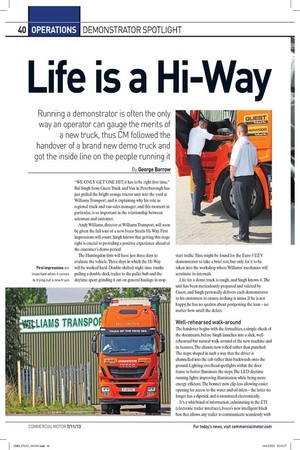Life is a Hi Way
Page 32

Page 34

If you've noticed an error in this article please click here to report it so we can fix it.
Running a demonstrator is often the only way an operator can gauge the merits of a new truck, thus CM followed the handover of a brand new demo truck and got the inside line on the people running it By George Barrow
"WE ONLY GET ONE HIT; it has to be right first time." Bal Singh from Guest Truck and Van in Peterborough has just pulled the bright orange tractor unit into the yard at Williams Transport, and is explaining why his role as regional truck and van sales manager, and this moment in particular, is so important in the relationship between salesman and customer.
Andy Williams, director at Williams Transport, will soon be given the full tour of a new Iveco Stralis Hi-Way. First impressions will count; Singh knows that getting this stage right is crucial to providing a positive experience ahead of the customer's demo period. The Huntingdon firm will have just three days to evaluate the vehicle. Three days in which the Hi-Way will be worked hard. Double-shifted: night-time trunks pulling a double-deck trailer to the pallet hub and the daytime spent grinding it out on general haulage in stop
start traffic. Time might be found for the Euro-5 EEV demonstrator to take a brief rest, but only for it to be taken into the workshop where Williams' mechanics will scrutinise its internals.
Life for a demo truck is tough, and Singh knows it. The unit has been meticulously prepared and valeted by Guest, and Singh personally delivers each demonstrator to his customers to ensure nothing is amiss If he is not happy, he has no qualms about postponing the loan — no matter how small the defect. Well-rehearsed walk-around
The handover begins with the formalities, a simple check of the documents, before Singh launches into a slick, wellrehearsed but natural walk-around of the new machine and its features. The chassis: now rolled rather than punched. The steps: shaped in such a way that the driver is channelled into the cab rather than backwards onto the ground. Lighting: overhead spotlights within the door frame to better illuminate the steps. The LED daytime running lights: improving illumination while being more energy efficient. The bonnet: now clip-less allowing easier opening for access to the water and oil inlets — the latter no longer has a dipstick and is monitored electronically. It's a whirlwind of information, culminating in the ETI (electronic trailer interface), Iveco's new intelligent black box that allows any trailer to communicate seamlessly with
the tractor unit, avoiding the warning lights and error codes that can occur due to the voltage disparities between LED and regular lamps.
Most of the changes are in the cab's interior where new materials contribute to a better look and feel — a fact Singh doesn't need to emphasise to his customers with prior knowledge of the Stralis. The demonstration vehicle is understandably equipped with a wealth of gadgets, but the standard list of in-cab items Singh is able to point out is considerable: fridge/freezer, air horn, pneumatic cab-controlled suspension, hill-hold, heated air-suspension seat, engine brake, three-piece lower bunk, and electric windscreen blind. Revisions to the sleeping area are among the most notable changes, with a three-piece bunk the most obvious: it allows the driver to sit comfortably at the new fold-down table when eating. Simple touches such as relocating the power supply socket within the bunk to the
same wall as the fold-down table (allowing TVs to be set up without trailing wires across the bunk) are among the minor but important changes that Singh runs through.
With Williams in the driving seat, Singh also demonstrates features such as hill-hold, and the hold reverse function that allows the truck to creep at 3km/h when going backwards. The integrated 7-inch monitor that incorporates telephone connection, music management and a series of apps, can also be specified with Qualcomm telematics, which not only delivers detailed reports to the operator (a feature used by Singh to debrief customers after the loan) but also provides the driver with real-time scores on their driving style and fuel efficiency.
Williams takes to the road, while Singh runs through the numbers. A six-cylinder in-line, 10.3-litre, Cursor 10 engine, producing 453hp and 2,100Nm of torque between 1,050rpm and 1,550rpm. Twelve-speed fully automated EuroTronic gearbox, 455-litre fuel tank with a 50-litre AdBlue reservoir. Ventilated front and rear disc brakes with ABS, EBS and BAS. Driver feedback
After a short test drive, during which Singh makes sure the customer is happy with the vehicle's controls and performance, the hour-long demonstrator handover is complete. Driver feedback forms are left so the vehicle's performance can be evaluated by anyone who takes to the road. Singh will return in a few days to collect the unit, and follow up the demonstrator loan with a courtesy call a few days later, allowing him to share the downloaded telematics reports and discuss the customer's thoughts on the vehicle. Williams is now free to put the unit to work, but next week Singh will perform the same process with another customer. EC Freight Services, Mark Doel Transport, Williams Transport and GE-BE Transport will all welcome the Hi-Way onto their fleets, and later give their candid opinions to CM on what life is like with the new Stralis. •








































